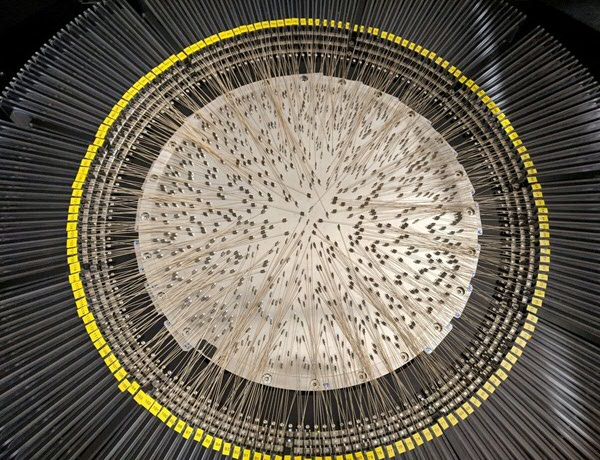Ingenious ‘woven’ spectrometer almost ready for use
WEAVE, an ingenious spectrometer with thousands of movable glass fibres, is almost ready for use by astronomers. This has been announced by a team of astronomers and technicians under the leadership of Scott Trager (University of Groningen). The spectrometer, including the two robots that arrange the glass fibres in changing configurations, has been successfully installed in the Dutch-British-Spanish William Herschel Telescope at La Palma.
Two thousand movable glass fibres
WEAVE stands for WHT Enhanced Area Velocity Explorer and is a spectrometer partly made in the Netherlands. The instrument can focus on over 900 stars or galaxies at the same time. With high precision, it unravels starlight into thousands of separate colours. The core of WEAVE comprises almost 2,000 movable glass fibres. The individual glass fibres are arranged in a way that they do not disrupt one another. From a short distance, it appears like a piece of lace or a loom, hence the name WEAVE. With WEAVE, astronomers can study the formation of stars and research how galaxies and the universe change.

Formation of the Milky Way
‘We are incredibly pleased that WEAVE is now almost ready for real observations’, states Scott Trager (Kapteyn Astronomical Institute, University of Groningen). Trager is the academic project leader of WEAVE and the chair of the WEAVE Survey Consortium that is set to deliver overview studies of the universe. ‘Due to travel restrictions arising from the coronavirus pandemic, it all took a little longer than planned, but now we can really get started.’ Over the coming five years, WEAVE will generate millions of spectra of stars and galaxies. The data from WEAVE could, for example, be linked to the data collections of the LOFAR telescope and of the Gaia space satellite. Through this, astronomers will gain further insight into how our Milky Way was formed, how the stars in this galaxy have evolved and how other galaxies are comprised.
Various components
The spectrometer comprises various components. The so-called prime-focus corrector ensures that each glass fibre absorbs more than 80% of the starlight. The fibre positioner consists of two robots that arrange the over 900 glass fibres in the desired configurations within an hour. Two cameras, each with 12,000 x 6,000 pixels, gather the resulting spectra. Two cryostats containing fluid nitrogen cool the digital cameras down, so that no image distortion occurs. Most of the components had arrived on Canary Island La Palma by the end of 2020. Due to travel restrictions arising from the coronavirus pandemic, this took longer than expected. Over the past few months, the astronomers have carried out standard tests and simple observations. In the coming two to three months, academic observations will take place as part of so-called science verification tests. Thereafter, astronomers from across the globe will be able to use the telescope.
More information
More news
-
19 December 2025
Mariano Méndez receives Argentine RAÍCES award
-
18 December 2025
Why innovate, and for whom?
-
17 December 2025
Ben Feringa wins Feynman Prize
